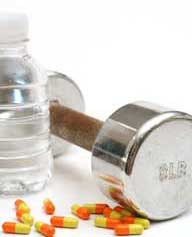
In last week’s article, I described sport in its purest form and how it can reveal the best elements of an athlete’s character. Unfortunately, this week’s post digs into the darker side of athletic competition.
Victor Conte, of the Balco performance-enhancing drug scandal, is now cooperating with drug–testing agencies and has divulged the doping schedule he used with his former client, British sprinter Dwain Chambers.
It’s shocking. Chambers used not one, or two, but SEVEN different performance enhancers, including steroids, insulin and stimulants! And he passed numerous drug tests before finally being caught.
THE DWAINE CHAMBERS DRUG REGIMINE
Here are the drugs he took:
THG. This drug is otherwise known as the designer steroid, “The Clear.” It was used during the off-season on Mondays and Wednesdays – the most intense days for weight training. It was placed under the tongue on those mornings and helped repair muscle tissue damaged during the strength training sessions. The cycle was three weeks on and one week off.
Testosterone/epitestosterone. Applied as a cream in the off-season, its purpose was to replace the deficiency of natural testosterone caused by using THG.
EPO. Thought to be useful only for endurance athletes, it was used to increase red blood cell count, allowing sprinters to perform extra track repetitions. It was used during the first two weeks of every four-week cycle during the off-season. The EPO was injected and is undetectable only 24 hours after an intravenous injection.
Human Growth Hormone (HGH). Injected Mondays, Wednesdays and Fridays during the off-season. It speeds recovery from strength training sessions.
Insulin. Chambers injected it immediately after intense weight training sessions during the off-season, along with a drink containing dextrose, protein and creatine. It promoted muscle repair and growth in addition to packing glycogen into depleted muscles.
Modafinil. Chambers took a tablet an hour before competitions. Acted as a stimulant to reduce feelings of fatigue and improve reaction time.
Liothryonine. This stimulant, designed to improve quickness, was taken one hour before competitions. There is currently no test for this drug.
DRUG USE SUMMARY
So that’s it. Two drugs to promote muscle repair from weight training, one drug to counteract hormone depletion caused by one of these drugs; another drug to allow more training repetitions; one to speed glycogen restoration; and two more to get the athlete “up” for the competition and improve reaction times during block starts. These drugs help the athlete develop a base of strength and fitness that will carry them through the competitive season.
THE DANGERS OF USING THESE DRUGS
What are some of the dangers of using these drugs? Insulin can be overdosed and play havoc with blood sugar levels. HGH can produce cardiac hypertrophy, which eventually can prove fatal. EPO can thicken the blood to the point that athletes can die in their sleep, when their blood pressure drops. And who knows the long-term effects of combining this cocktail of potent drugs.
HOW ATHLETES BEAT THE DRUG TESTS
Is this just a “track and field” program? Of course not. Victor Conte worked with athletes from a number of different sports, including professional baseball.
In fact, track and field has long had the most comprehensive drug testing program of any competitive sport. That’s why it has such a bad reputation for drug use – unlike many of its professional counterparts, the sport has a history of actually catching drug cheats. But how did athletes like Chambers escape the testers?
According to Conte, they used the “Duck and Dodge” strategy. They called their own cell phone until its message capacity was filled. And they filled out incorrect information on their “whereabouts” form, so they couldn’t be contacted. After a cycle of drug use, when they knew they were clean, they would reappear, claiming that their unavailability was a mistake.
Under current rules, athletes are allowed two such mistakes in an 18-month period. Athletes would hope they wouldn’t be contacted for a drug test during their doping cycle, but if they were, they knew they would get two chances before being in danger of sanctions. If they were unfortunate enough to miss a second test “by mistake,” they would simply stop doping.
HOW TO IMPROVE DRUG TESTING
Conte did suggest a method for catching more doped athletes. He strongly advises that most testing be conducted in the fourth quarter of the year, when most drug use is occurring. However, at present only 15% of testing is conducted in this quarter.
Obviously, changes must be made – both in the timing of drug tests and in the penalties applied to those who miss random tests. And there is no doubt that Chambers, and those who follow similar performance-enhancing regimens, did not inadvertently “make a mistake.” Penalties in such a case must be severe and a lifetime ban is definitely appropriate.
Reference: “Victor Conte lays out Dwain Chambers’ doping/steroid protocol; Does Blue Cross/Blue Shield cover this?” Steroid Nation, 5/15/08.
Steroid Nation is an online journal that looks at the use of performance enhancing drugs in sports, youth and society. It is written by Dr. Gary Gaffney, M.D., of the University of Iowa College of Medicine.
Dick Moss, Editor,
PE Update.com
To subscribe to the free PE Tips of the Week Newsletter, Click Here!
To check out the PE Update.com website, Click Here!
[tags]performance enhancing drugs,steroids[/tags]






